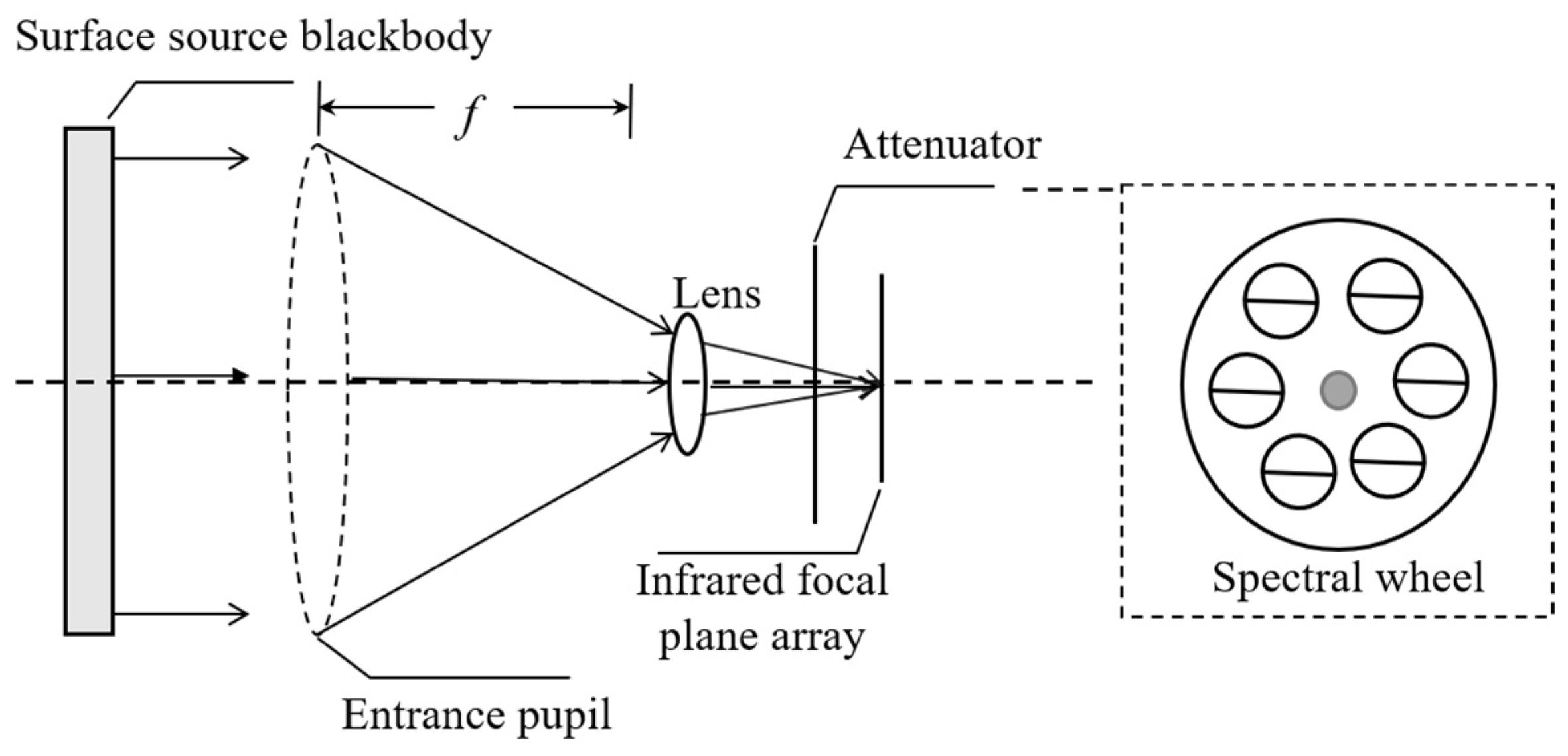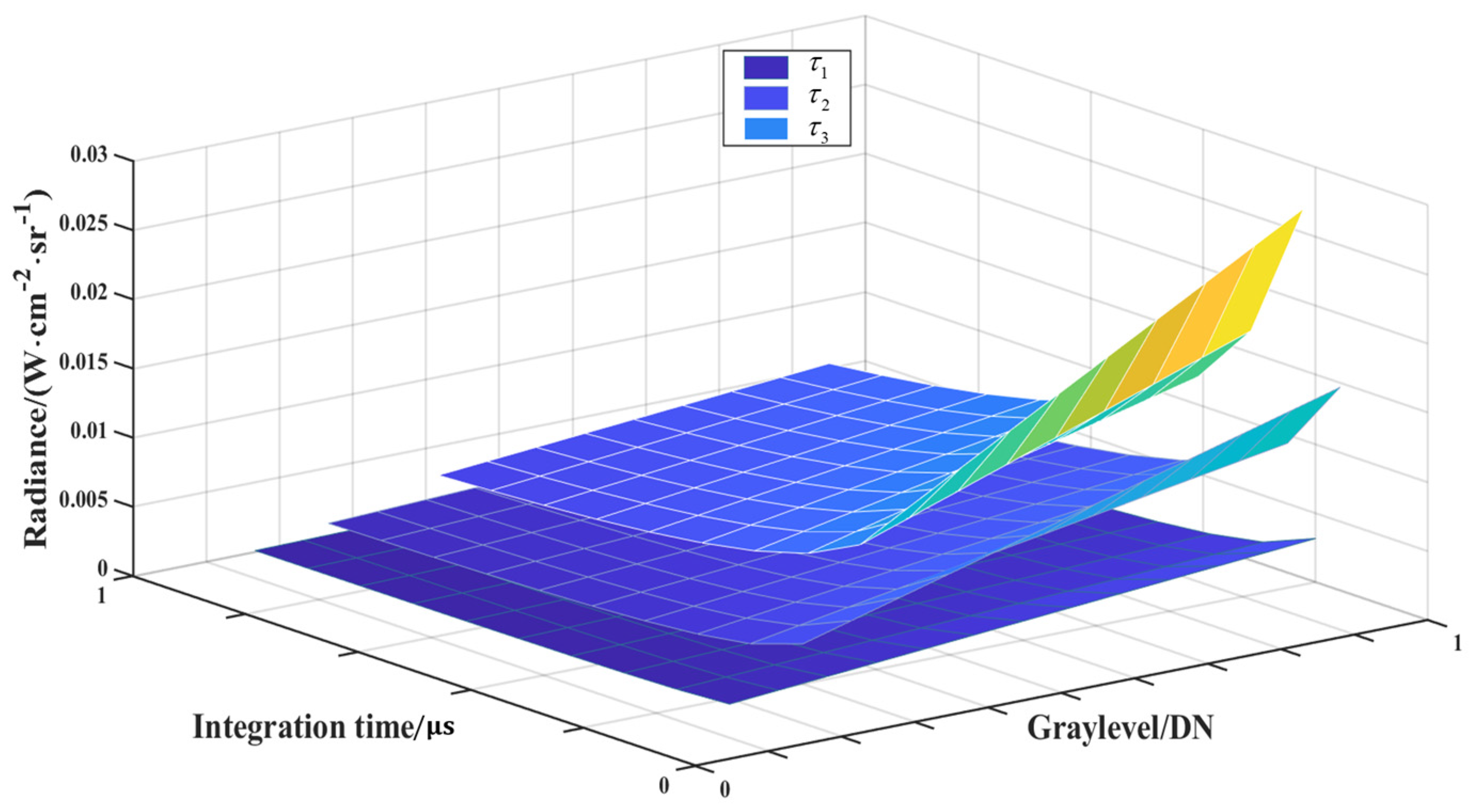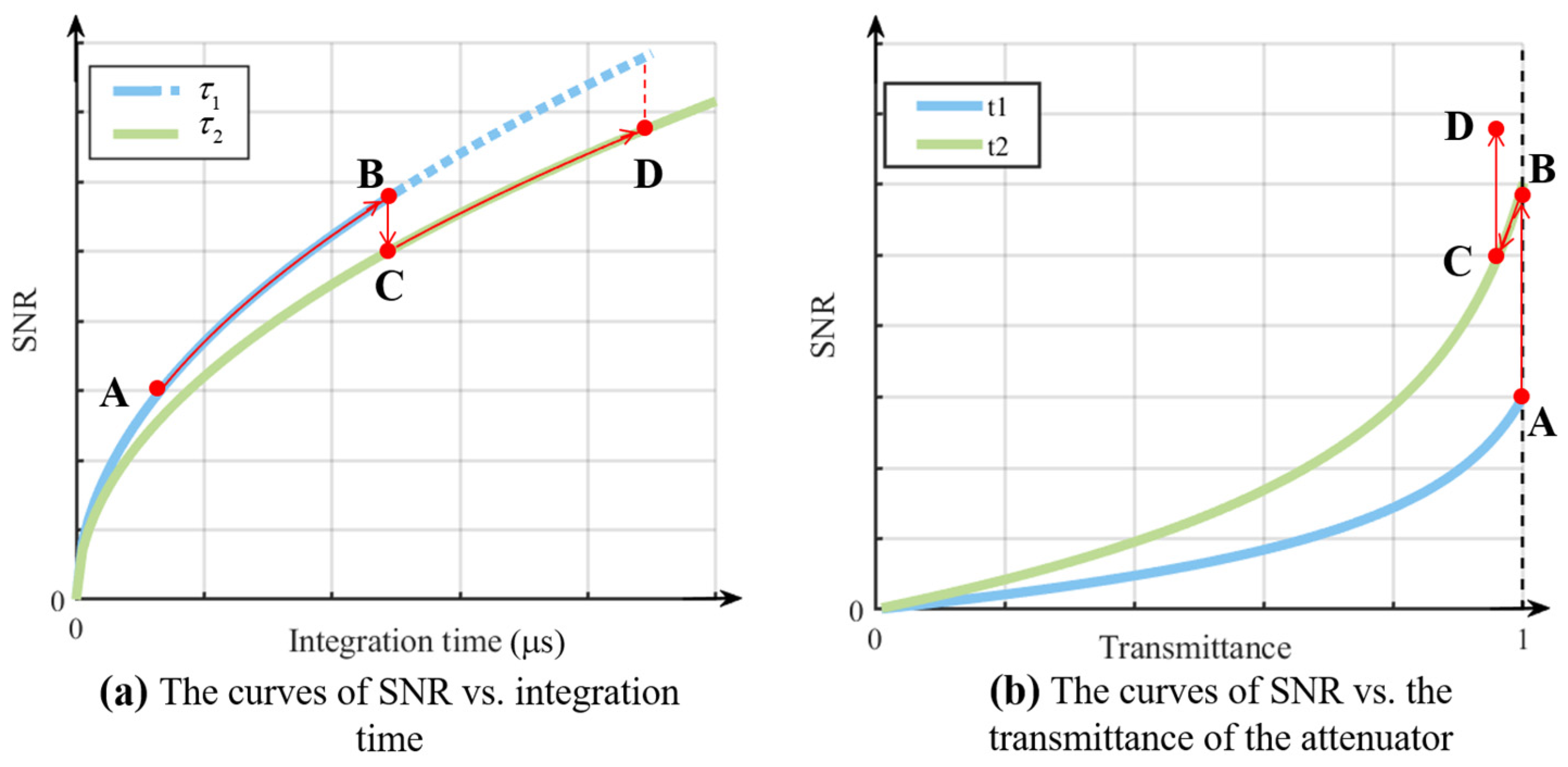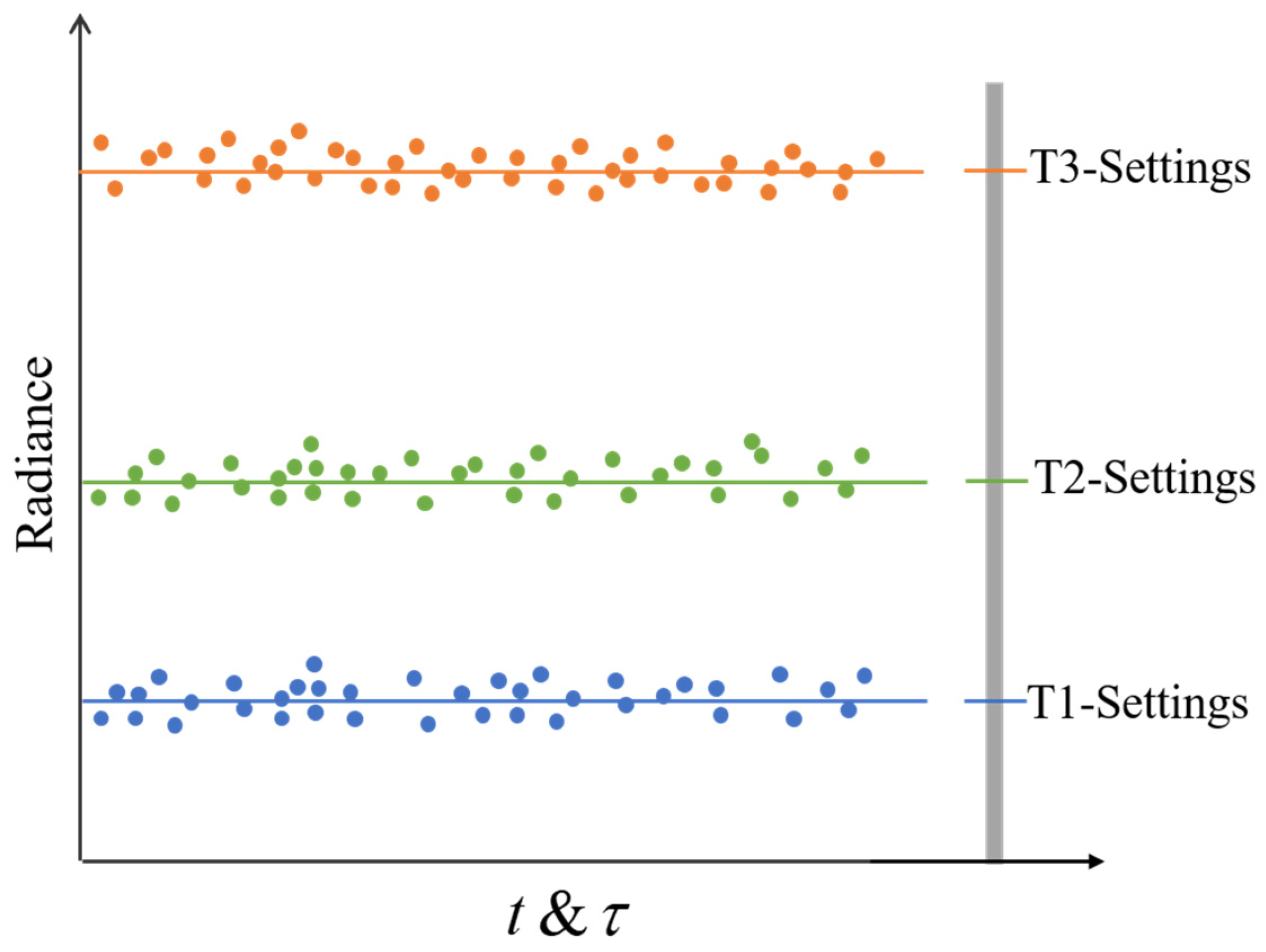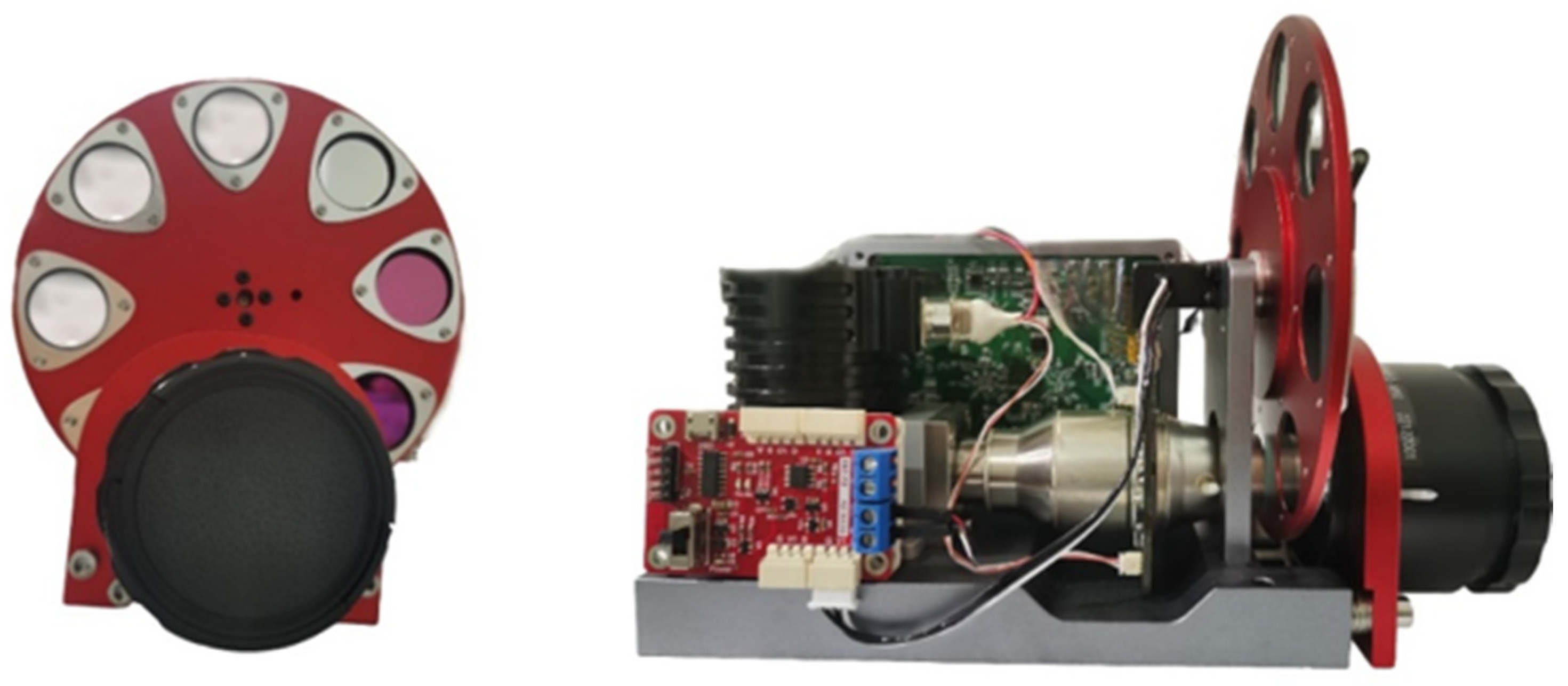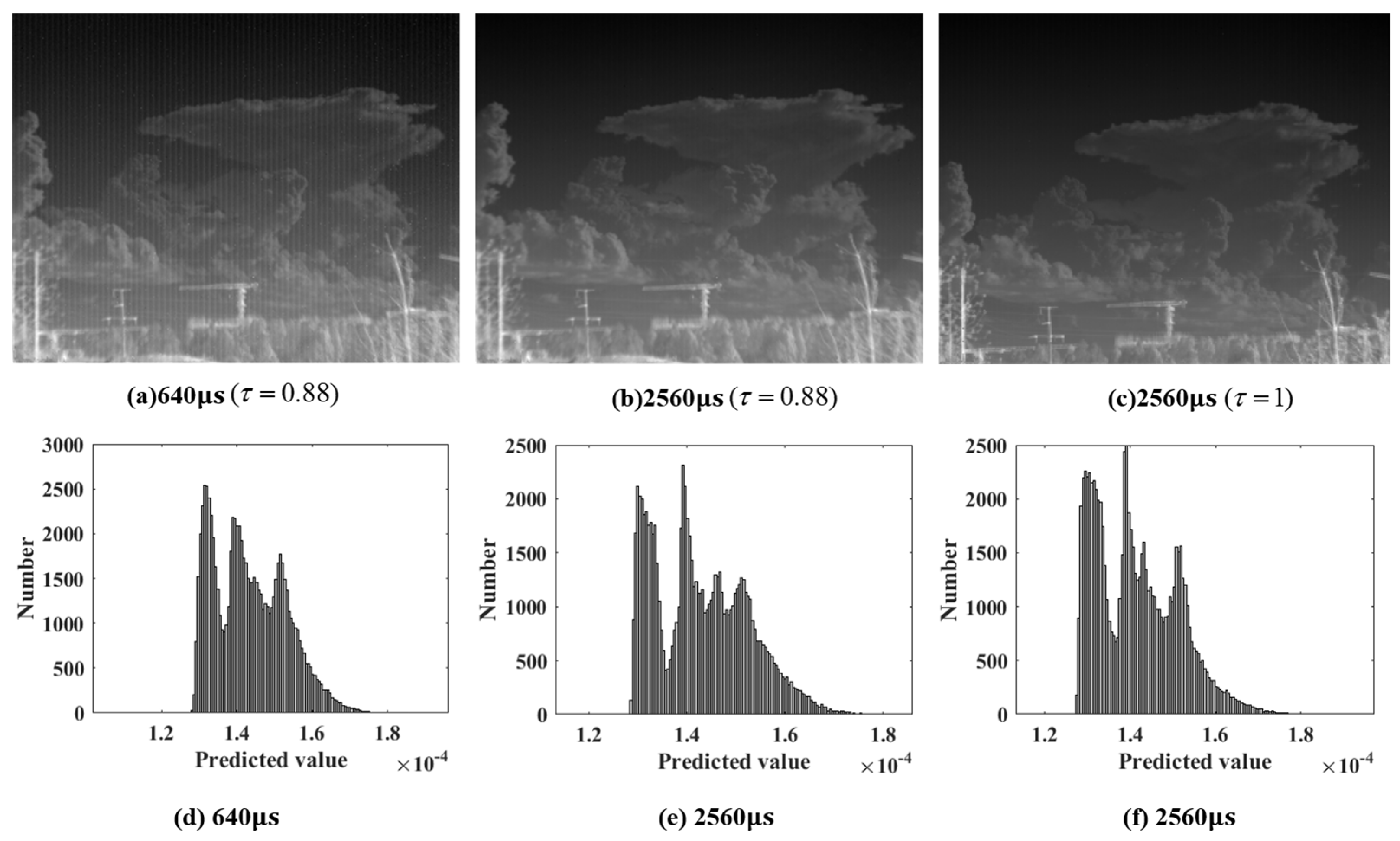1. Introduction
Infrared thermal imaging technology is utilized in various applications, including night vision detection, autonomous driving, medical research, and power-fault diagnosis. Its widespread adoption has been attributed to its robustness against electromagnetic interference, low power consumption, and ability to perform noncontact passive imaging [
1]. Infrared systems typically capture images with significantly more noise compared to visible light imaging systems due to the theoretical limitations, detector manufacturing technology, and inherent properties of infrared imaging. A critical factor influencing the quality of image processing is the nonuniformity of pixel responses, which are usually represented as fixed pattern noise (FPN). FPN manifests as strips, block patterns, and gentle brightness changes on infrared images, adversely affecting the quality of infrared imaging.
Numerous studies on the nonuniformity of infrared systems have been conducted by researchers [
2,
3,
4,
5,
6,
7]. Nonuniformity correction methods can be broadly classified into the following two categories: calibration-based and scene-adaptive methods. Calibration-based methods involve inversely calculating an actual input by calibrating the response curve of a detector pixel. Common techniques include one-point, two-point, and multi-point correction algorithms [
8]. Scene-adaptive approaches calibrate an infrared imaging system in a manner that is adaptive to a scene, and this usually includes high-pass filtering, statistical, and registration-based methods [
9]. These methods do not require blackbody calibration. Moreover, there have been advancements in dynamic-range adaptive adjustments to nonuniformity correction methods. They extend the application range of an infrared system to target temperatures, ensuring the target region consistently operates within an optimal dynamic range, thereby enhancing image quality. K.C. et al. proposed a nonuniform correction technique for adaptive integration time changes using multi-point correction [
10]. W.S. et al. suggested employing a Kalman filter to predict the scanning gray values of linear systems, which would then be used to indirectly predict integration times, thereby realizing the adaptive management of the infrared detectors’ dynamic range [
11]. N.C. et al. suggested a one-time calibration-based two-dimensional spatial nonuniformity correction technique that eliminated the calibration process’s reliance on integration time [
12]. Since these correction methods are adaptable to integration time changes in the gray-level domain, changing the integration time will consequently change the output gray level.
In addition to adjusting a system’s integration time, adding an attenuator is also an effective method for expanding the dynamic range [
13]. However, adjusting the system’s dynamic range will introduce additional nonuniformity. There is limited research on nonuniformity correction algorithms that simultaneously consider the integration time and attenuator. Furthermore, using traditional nonuniformity correction methods, the brightness of an image will also change when the transmittance of the attenuator changes. The energy-domain nonuniformity correction method usually requires accurately known blackbody temperatures, emissivity, and wavebands to calculate theoretical radiance. However, the deviation of a blackbody temperature, emissivity, and waveband from a ground-truth value will affect calibration accuracy.
In this study, an energy-domain infrared (IR) nonuniformity (NUC) method based on unsupervised learning was introduced. Firstly, a unified database is established by integrating the gray level, integration time, and attenuator information, and this is based on the derived infrared physical model. By setting the average predicted value of the same blackbody temperature as the learning goal, the coefficients of the model are learned through a clustering-based unsupervised learning methodology. The proposed method does not need to know the accurate blackbody temperature, emissivity, and waveband of the calibration points. The trained correction network can maintain a uniform and stable output when the dynamic range changes, which is beneficial to the post-processing of the infrared system. Finally, the experiments are performed on an experimental infrared imaging system.
2. Correction Model Derivation
The radiometric calibration of an imaging system is essential for a calibration-based nonuniformity correction method. This section derives a physical model for infrared radiometric calibration. To ensure the detector operates within its optimal dynamic range, a gray-level adaptive adjustment mechanism is also integrated.
2.1. Physical Model of the Infrared Radiometric Calibration
There are several radiometric calibration configurations used in infrared imaging systems [
14,
15]. The two most commonly used calibration configurations are near-collimating optics configuration and near-extended-source (NES) configuration. A near-collimating optics configuration performs radiometric calibration by expanding a collimated beam from a cavity blackbody, with incident radiation from a smaller source also filling the entry pupil. This configuration is costly and has constraints in laboratory settings. In the NES configuration, a surface blackbody is positioned at the system’s entrance pupil, ensuring that the incident radiation covers the entry pupil during calibration. This method offers high accuracy and effectively minimizes external influences such as atmospheric attenuation. However, due to manufacturing limitations, the dynamic temperature range of the extended area blackbody is limited, rendering the NES configuration unsuitable for wide dynamic range radiometric calibration.
The near-extended-source configuration is used in the study.
Figure 1 shows the radiometric calibration diagram.
Assuming that the infrared imaging system operates within the linear response range, the relation between the radiance at the system’s entrance pupil and the gray level of the output infrared image is linear [
16,
17,
18]. The expression is given as follows:
where
represents the gray level,
is the integration time,
represents the total system gain that takes the electrical and optical systems into account, and
is the gray level offset term of the detector, which is caused by internal factors such as dark current.
represents the internal equivalent stray radiation of the system, which can be conceptualized as equivalent radiation from the optical system’s incident upon the entrance pupil. Calculating the stray radiation at the entrance pupil facilitates the comparison of the relative magnitudes between stray radiation and the target radiance, especially when the dynamic range is altered. It endows the stray radiation term with a tangible physical significance.
is the target radiance, which can be calculated using Planck’s blackbody radiation formula [
1]. It can be expressed as
where
is the emissivity of the blackbody,
is the Planck constant with the value of
,
is the speed of light with the value of
,
is the Boltzmann constant with the value of
,
is the wavelength of radiation, and
is the Kelvin temperature.
When an attenuator is interposed between the detector and the optical lens of the infrared imaging system, it linearly diminishes all incoming radiation. Concurrently, the stray radiation associated with the attenuation is incorporated into the radiometric calibration model. Equation (2) can be rewritten as
is the transmittance of the attenuator. is the equivalent radiation from the attenuator, and it can be viewed as the attenuator’s equivalent radiation incident from the entrance pupil, as in . The max value of is determined by the number of used attenuator gears in the infrared system. The above physical quantities are for a single pixel in the infrared FPA detector. Nonuniformity correction can be performed in the gray-level domain based on Equation (3).
Equation (3) is changed to a function of the radiance concerning the gray level. The expression is given as follows:
Equation (4) is usually solved by collecting blackbody images at multiple operating points and calculating their theoretical radiance. The coefficients , , , , and of radiance concerning integration times and gray levels are obtained. Based on Equation (4), nonuniformity corrections can be performed in the energy domain.
2.2. Dynamic Adjustment Mechanism
The goal of the dynamic adjustment mechanism is to keep the detector in the optimal dynamic range while maintaining a satisfactory corrective effect in the output images of the system. The linear calibration range with high calibration accuracies is used as the linear dynamic range of the system. It is derived based on Equation (4), a known linear model. When the range of the gray level and the integration time are known, Equation (4) can be used to describe the relation of the radiance concerning integration times and gray levels. A sample of the relation is shown in
Figure 2.
In
Figure 2, the magnitude relation of the transmittance is
. The stray radiation of the uncalibrated attenuator at a specific ambient temperature can be estimated using Equation (2) [
19]. The range of the integration time is determined by the system’s settings. The gray-level range is established through calibration and dynamic processes. The lower limit of the dynamic gray range increases as the attenuator’s transmittance descends. Both integration times and gray levels are normalized for better exhibition.
As the attenuator’s transmittance decreases, the curvature of the surface increases, indicating a broader dynamic range of radiance. Given a fixed integration time, a lower attenuator transmittance results in a reduced gray-level range detectable by the system. Both adding an attenuator and adjusting integration times are effective methods for expanding the system’s dynamic range.
The operating points in the linear calibration range may not have optimal correction effects, and this is due to the influence of the signal-to-noise ratio (SNR) [
20,
21]. System background noise primarily includes photon, dark current, and readout circuit noise [
22]. Photon noise is composed of stray radiation noise from the optical lens and the attenuator. Consequently, SNR can be expressed as
For a certain infrared imaging system and a certain target, the values of
,
, and
will vary with the adjustment of integration times and the transmittance of the attenuator.
is associated with the intrinsic properties of the attenuator.
and
are determined via the characteristics of the detector and the readout circuits of the system.
Figure 3 is a graphical representation that illustrates the general trend based on Equation (5).
Figure 3a describes the relation between SNR and integration time at two attenuator gears.
is determined when the attenuator is chosen. In the optimal dynamic range of the system, the SNR will increase with an increase in integration times. Points A, B, C, and D are four different operating points. When the SNR is low at point A, it can be enhanced by increasing the integration time. When the gray value reaches the upper limit of the system’s linear response range at point B (as shown by the dotted line in
Figure 3a, if the upper limit is not reached, SNR can continue to increase by increasing the integration time), a lower transmittance of the attenuator is switched to in the optical path at point C. Although this step reduces SNR, a higher value can be achieved by increasing the integration at point D.
Figure 3b describes the relation between SNR and the transmittance of the attenuator at two integration times. When the integration time is determined, noise received by the detector will increase due to the stray radiation introduced by the attenuator. The stray radiation of the attenuator will increase with a decrease in transmittance. The steps from A to D describe the same physical process as that in
Figure 3a.
Different operating points can be achieved by setting the integration time and the attenuator. In the process of dynamic range adjustment, three variables can be taken into account: minimum gray level
, maximum gray level
, and average gray level
of the infrared image. These three variables are compared with the optimal dynamic range of the system. There are three situations:
where
represents the subset of the linear response range of the system, with different operating points corresponding to different
:
- (1)
When , the integration time should be increased until . If the integration time reaches the maximum value of the system’s setting and is still less than , the attenuator with higher transmittance is switched into the optical path.
- (2)
When , the system is within the optimal dynamic range. No further action is needed.
- (3)
When , the integration time should be decreased until . If the integration time reaches the minimum value of the system’s setting and still exceeds , the attenuator with lower transmittance is switched into the optical path.
3. Nonuniformity Correction Method Based on Unsupervised Learning
Existing nonuniform correction algorithms typically operate in the gray-level domain. Adjustments of the system operating points, such as the transmittance of attenuators and/or integration times, will change the gray level of infrared images captured from the same scene as well. The adjustments result in outputted gray-level jumps, complicating the post-processing of the infrared system, such as target detection, tracking, and recognition. Switching from the gray-level domain to the energy domain can solve the problem effectively. However, the energy-domain nonuniformity correction approach usually needs to accurately obtain blackbody temperatures, emissivities, and wavebands. The deviation from the ground-truth value will affect calibration accuracy.
In reference [
16], Equation (4) is solved by utilizing the loss function and backpropagation of the BP network. The iterative process of the coefficient’s learning network converges to the global optimal solution. The algorithm uses the theoretical radiance calculated from the blackbody temperature as the regression goal for training the coefficient’s learning network. The feedback value is defined as the difference between theoretical radiance and the network-predicted value. During training, the calibration points at the same blackbody temperature will cluster together, and the distance between the network-predicted value and theoretical radiance is minimized. This is a result of all calibration points being correlated by Equation (4), and radiance is calculated via blackbody temperatures, emissivities, and wavebands.
Based on the above, the calibration points of the same temperature will automatically cluster together according to the physical correlation; thus, theoretical radiance can be replaced by the average predicted value at the same blackbody temperature settings. This clustering process is similar to the K-means clustering mechanism [
23,
24].
Figure 4 illustrates the schematic diagram of blackbody radiance clustering. Each horizontal line represents a cluster center. T1~T3 are unknown blackbody temperature settings. Each dot represents a specific operating point in the figure. In each cluster, the average position is determined using the same specific blackbody temperature settings. The selection of the temperature should be within the dynamic range’s boundary, and the interval should not be small; otherwise, the calibration’s accuracy would be affected.
Consequently, a nonuniformity correction approach based on unsupervised learning is proposed. Each operating point will not be labeled during the training process. The clustering center is determined by the average predicted value generated using Equation (4) with respect to calibration data at the same specific blackbody settings. In the clustering process, the center of each cluster continuously shifts until the distances between the cluster’s operating points and the center are minimized. The number of clustering centers corresponds to the calibration’s blackbody temperature settings. The goal of the calculation is to minimize the differences in the network-predicted value and the average predicted value. Thus, Equation (4) can be rewritten as
where
,
,
,
, and
are learned from the unsupervised coefficient learning network.
is the predicted value of the specific operating point. The expression of
is given as follows:
where
is the number of calibration points at the same specific blackbody temperature, (
i,
j) is the pixel coordinate of the detector,
is the serial number, and
and
are the rows and columns of the infrared FPA, respectively.
The mechanism of the unsupervised clustering algorithm and coefficient learning model is shown in
Figure 5. The forward network structure for regression is first built and divided into three layers: the input layer, the calculation layer, and the output layer. The input layer consists of the gray level
of the blackbody image and its corresponding integration time
and attenuator selection coefficient
.
is the enable signal: the selected attenuator is 1, and the rest are 0. The calculation layer is based on Equation (7). The output layer is composed of the average predicted value of all calibration data at the same specific blackbody temperature settings. Once the initial values for each coefficient in Equation (3) of the learning network are set, the initial average predicted value
is established. The loss function is defined as the sum of the squares of the relative errors between the predicted value and the average predicted value. The equation is given as follows:
where
is the sequence number of the calibration points and
is the total number of calibration points. To determine the direction of the gradient’s descent, the chain rule is applied to compute the partial derivative of each coefficient. During the gradient descent process of the neural network, solving the molecular section results in the formation of a high-order term. It will affect both the convergence of the gradient descent and the stability of the network’s training. Thus, the reciprocal of the coefficients in the denominator in Equation (7) is regarded as a whole term. The equation is given as follows:
where
is obtained as follows:
Then, the learning direction of the coefficients is obtained as follows:
It should be noted that the training goal is set as the average of the predicted value and not the true radiance value; thus, the predicted value can only be used for nonuniformity corrections and cannot be regarded as the radiance value. The predicted value and the radiance value have a linear relation at the same temperature, which can be written as
Linear coefficients and represent how the predicted value maps to the radiance value. Linear coefficients and can be determined by using at least two known blackbody temperature settings.
5. Conclusions
This study proposes an energy-domain IR NUC method adapted to dynamic range changes based on unsupervised machine learning. Firstly, an energy-domain infrared physical model is established, and a dynamic adjustment mechanism is introduced to ensure that the system operates within the optimal dynamic range. Then, by exploring the inherent physical correlations within the calibration dataset, a unified database is generated by integrating gray levels, integration times, and attenuator information. Without knowing the calibration’s blackbody temperature, emissivity, and waveband, the coefficients of the correction model are learned based on the clustering-based unsupervised learning methodology by setting the average predicted value of the same blackbody temperature as the learning goal. The experiment’s results show that the trained correction network maintains uniform and stable image outputs during the adjustment of the integration time and attenuator, and it keeps the infrared system operating within the optimal dynamic range. The maximum change in the image corrected by the proposed algorithm is 1.29%.
A potential application of the proposed method is the calibration-based radiation measurement. The radiation calibration errors are partially introduced by the mismatch between the calculated theoretical radiance and true radiance. One reason for this phenomenon is that the actual blackbody temperature might be different from the preset temperature due to the equipment’s accuracy and the insufficient time elapsed to reach the temperature balance. The other reason is that the emissivity of the blackbody is usually treated as a fixed value in the calculation but, actually, it conforms to a specific spectral response within the working waveband. The proposed method avoids using the exact blackbody parameters during the clustering-based unsupervised training stage and provides a new solution as a reference.
